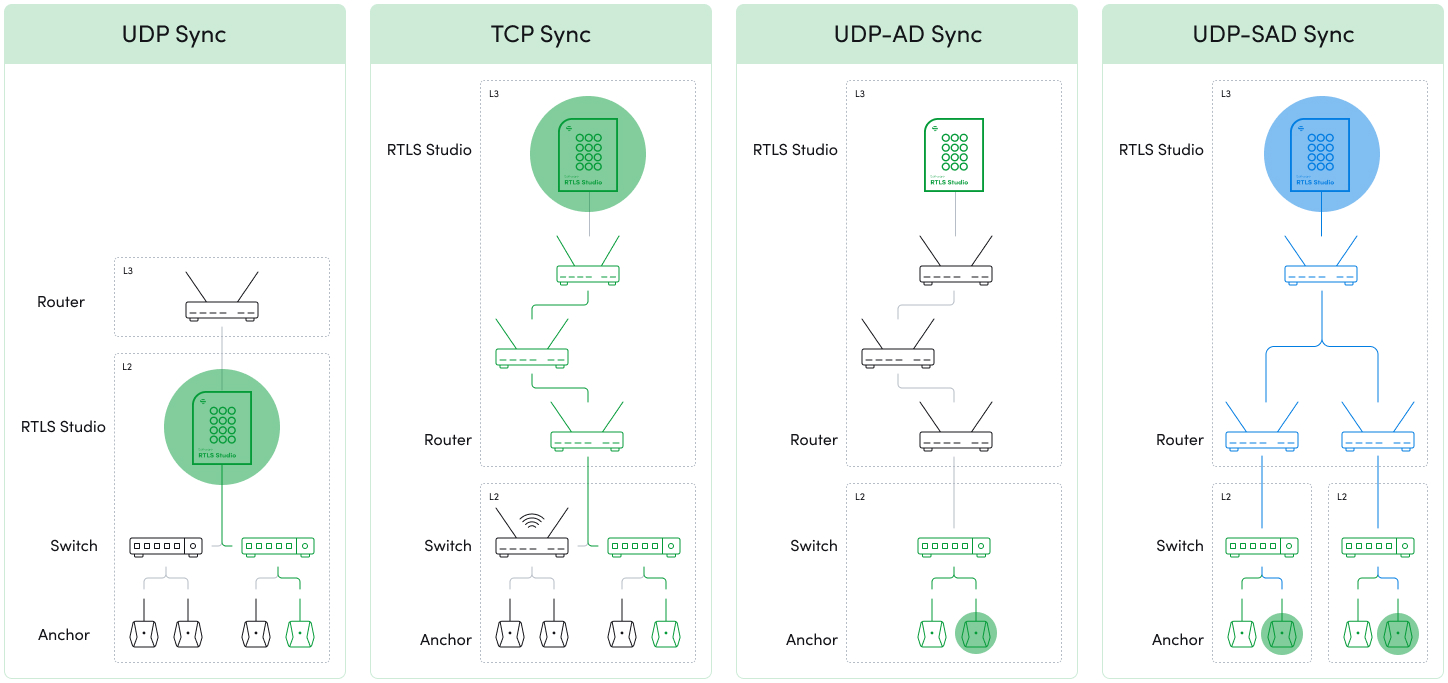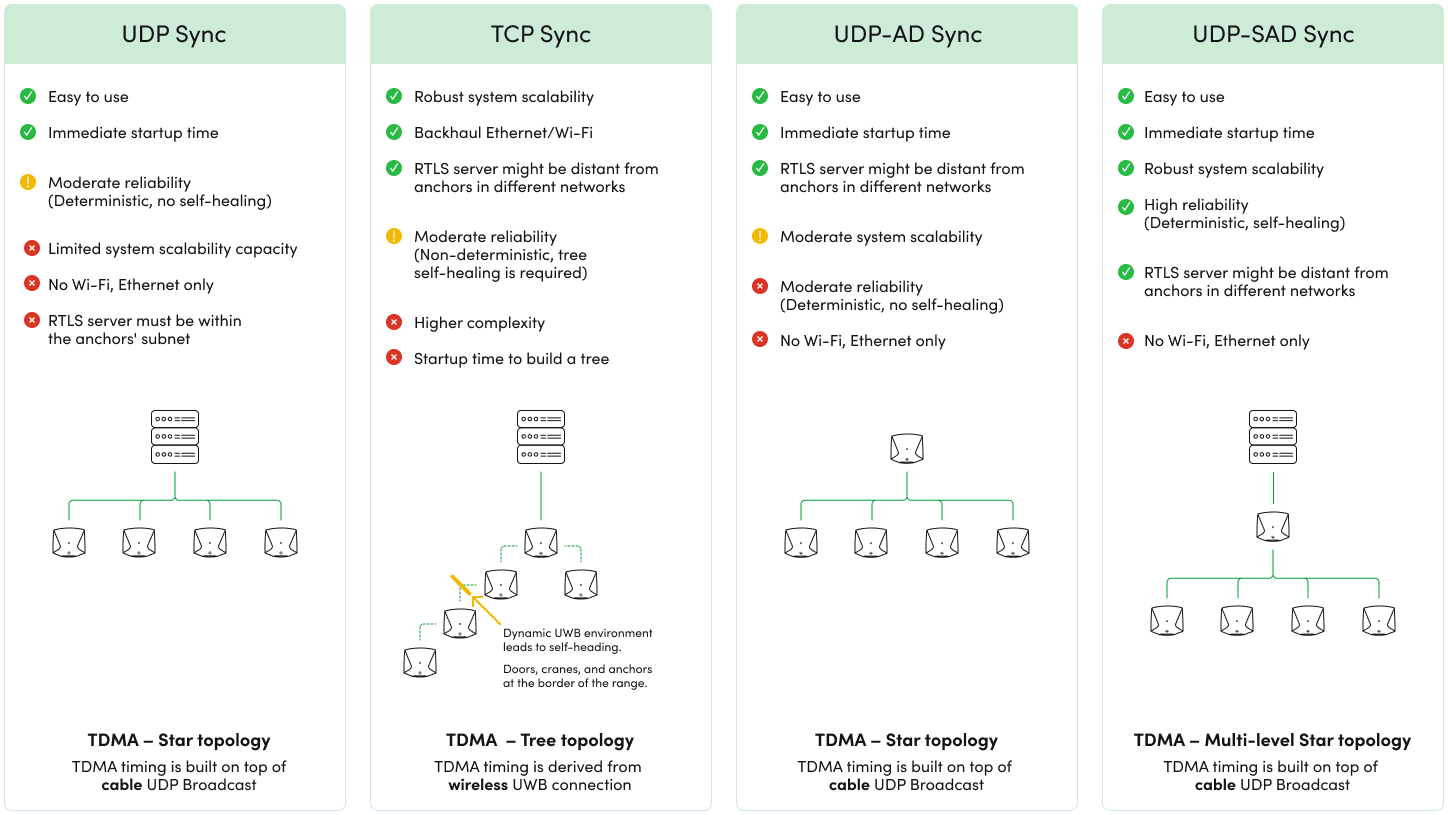TDMA Synchronization
Anchor Synchronization in TDoA Location Systems
Precise anchor synchronization is a cornerstone of the Time Difference of Arrival (TDoA) localization system, enabling sub-meter positional accuracy (1 ns = 30 cm). Achieving this level of precision requires sub-nanosecond synchronization, accomplished via Ultra-Wideband (UWB) radio communication. A master anchor transmits timing signals to other anchors within its line of sight. This synchronization process is periodic and initiated by the server through the backhaul network (Ethernet/Wi-Fi). Given that an RTLS deployment can include multiple master anchors, UWB transmissions must be carefully organized into microsecond-aligned timeslots to prevent interference.
Synchronization Schemes in Sewio RTLS
Sewio RTLS offers four distinct synchronization methods, each tailored to different deployment needs and network conditions:
UDP Synchronization → Fast, lightweight sync via a single UDP broadcast.
TCP Synchronization → Reliable sync over TCP with self-healing for dynamic environments.
UDP-AD Synchronization (Anchor-Driven) → Localized sync managed by a subnet's designated anchor.
UDP-SAD Synchronization (Studio-Anchor-Driven) → Centralized timing from RTLS Studio with local anchor-driven sync.
Pros and Cons
Below you can find pros and cons of all, TCP, UDP, UDP-AD, and UDP-SAD:
Sewio strongly recommends placing the RTLS Studio host server in the same subnet as positioning system anchors to provide the best possible reliability and performance. The highest reliability requires UDP Sync mode on anchors activated. UDP Sync between server and anchors can operate only within the same subnet, making it the simplest synchronization method for deployments where all devices are located in a single network.
If TCP Sync is used, the host server can be distant, providing more flexibility. TCP Sync also offers higher channel capacity and supports both Ethernet and Wi-Fi. However, anchors within the network are logically organized into a tree structure. Building this tree may take from seconds to minutes, depending on the deployment size, and dynamic environments with large metal objects (e.g., cranes) can disrupt links between anchors. In such cases, the network undergoes a self-healing process, which reorganizes the tree. During this reorganization, the location data for the affected area (sub-tree) might be temporarily unavailable. While TCP Sync is robust and flexible, its complexity and dependency on self-healing make it less suitable for dynamic and highly reliable environments.
UDP-AD (UDP Anchor-Driven) Sync is an advanced evolution of TDMA slot alignment via UDP broadcasting over Ethernet. Unlike standard UDP Sync, UDP-AD removes the requirement for the RTLS Studio server to be within the same L2 network as the anchors. Instead, synchronization is managed by a dedicated anchor within each subnet, which drives the synchronization for other anchors locally. This approach provides exceptional stability, even in harsh environments, and eliminates the need for self-healing processes typically associated with TCP Sync. Furthermore, UDP-AD seamlessly integrates with RTLS Studio deployed in a Docker environment, offering a flexible and scalable solution for modern deployments.
UDP-SAD (UDP Studio-Assisted Anchor-Driven) Sync is Sewio's recommended TDMA protocol for achieving the highest reliability and scalability in demanding environments. This protocol combines the robustness of UDP-AD with centralized timing management from RTLS Studio. Anchors are synchronized locally within subnets by a designated anchor, while RTLS Studio supervises and coordinates the UDP broadcasts for enhanced timing precision and network control. UDP-SAD enables reliable operation in dynamic environments with support for large deployments and harsh conditions. Unlike other synchronization methods, UDP-SAD ensures a hierarchical star topology, allowing centralized control and self-healing capabilities without interruptions to location data. This makes UDP-SAD the preferred choice for deployments requiring robust performance, flexibility, and scalability.
Combination of different synchronization schemes among Anchors within single deployment is not allowed. All Anchors must be set either to TCP Sync, UDP sync or UDP-AD Sync.
Comparison
Here is a brief comparison table:
Synchronization Scheme | UDP Sync | TCP Sync 2nd Gen | UDP-AD Sync | UDP-SAD Sync |
Maturity Level | STABLE | STABLE | STABLE | BETA |
Backhaul protocol | UDP Broadcast | TCP Unicast | UDP Broadcast | TCP Unicast + UDP Broadcast |
| Port | UDP/5001 | TCP/5001 | UDP/5001 | TCP/5001, UDP/5001 |
| Communication Direction | RTLS Studio - Transmitter / Anchor - Receiver | RTLS Studio - Transmitter / Anchor - Receiver / Anchor - Transmitter / RTLS Studio - Receiver | Anchor - Transmitter / Anchor - Receiver | RTLS Studio - Management / Anchor - Transmitter / Anchor Receiver |
| Sync Topology | Star | Tree | Star | Hierarchical Star |
| Startup Time | Immediate | 1 - 5min (300 anchors) | Immediate | Immediate |
RTLS Studio location | Must be within the same L2 network - same broadcast domain Router cannot be on the communication path. | No limitations* Cannot have NAT on the network path | RTLS Studio could be in the different subnet then anchors. The selected anchor sends a synchronization message. The selected anchor must be within the same L2 network - same broadcast domain. Cannot have NAT on the network path. | RTLS Studio could be in the different subnet then anchors. The selected anchor must be within the same L2 network - same broadcast domain as it combines local anchor-driven synchronization with centralized timing from RTLS Studio. Cannot have NAT on the network path. |
Ethernet backhaul | Complete | Complete | Complete | Complete |
Wi-Fi backhaul | Ethernet only | Scalable Access Point topology | Ethernet only | Ethernet only |
Mixed Ethernet/Wi-Fi backhaul | No | Yes | No | No |
RTLS Studio | >=1.3.2 | >=2.3 | >=2.5 | >=3.4 |
Anchor FW | >=1.000 | >=3.002, recommended 3.005 | >=3.1.5 | >=3.4.0 |

